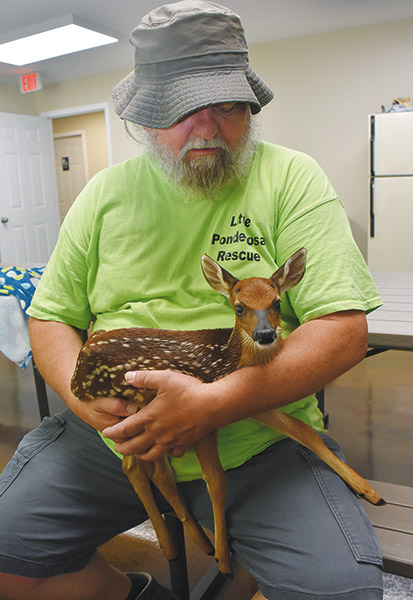Babies galore!
LPZ starting to look like a nursery
It’s baby-rescue season at Clinton’s Little Ponderosa Zoo and Rescue.
That’s what spring brings, and as a result, the zoo’s various “nurseries” are chock full of orphaned little ones, including about 40 deer, 50 opossums and 60 or more raccoons, among others.
Most of them require careful, around-the-clock feeding and attention, and as a result, the zoo staff is operating on three shifts to take care of them, said James Cox, founder and director of the Little Ponderosa.
“We will raise them until they’re big enough to take care of themselves, and we will release all of them back into the wild when they’re ready,” he said Saturday as he held an orphaned two-day-old fawn that had come in just that morning.
“This one was brought in by a veterinary clinic, where the staff saw its mother get killed by a car on the road out front,” Cox said.
“We just turned about a dozen young possums loose in the woods this past week, and in the fall, we will release the young deer in a state Wildlife Management Area [near Royal Blue in Campbell County],” he said.
The zoo has permits from the Tennessee Wildlife Resources Agency to rehabilitate deer, raccoons and opossums, among other animals.
This year has been especially hard on the raccoons, Cox said. The zoo got four babies in on Saturday from the TWRA, and they just keep coming.
Baby deer are common rescues, but some of them could be left in the wild and would still be taken care of by their mothers if people didn’t sometimes rush to save fawns that aren’t in distress, he said.
“If you see a baby deer that you think might be an orphan, look at its ears,” he said. “If the ear tips are curled down, then the baby is dehydrated and in distress, and the mama probably isn’t coming back. But if the ears are normal, the baby might still have a mama taking care of it. Watch it for a day or two first.”
When the baby deer come in, “We de-flea and de-tick them, and weigh them,” Cox said.
Then they are fed a special baby deer formula called Fawn-Lac, which Cox said costs a whopping $245 for a 45-pound bag.
“We will use over $10,000 worth of Fawn-Lac this year,” he added.
“We have to run three shifts, because the babies have to eat around the clock,” he said.
“And we have so many calls coming in now for rescues that I have to forward the zoo’s phone to my cellphone when I leave in the evenings, so I don’t miss any of the calls,” he said.
Meanwhile, the Little Ponderosa reopened to visitors in May, after being closed by the COVID-19 restrictions for about two months
And on Saturday, there were plenty of families with lots of kids who came to tour the facility.


